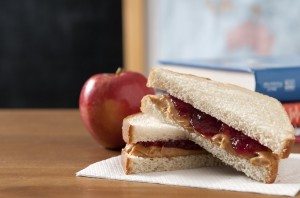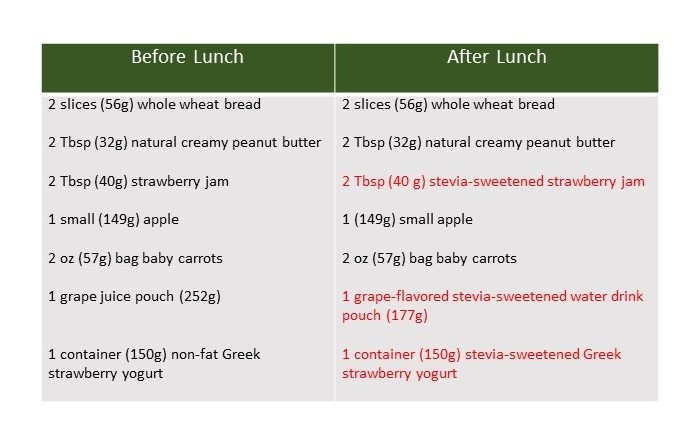Think Outside the (Lunch) Box for Sweet Swap-Outs

By Kerry Neville
As a parent, have you ever considered the amount of sugar your child may eat in a day? It can add up quickly, when you factor in all of the sweetened foods and beverages kids often eat at meal and snack time. On average, in the United States, both boys and girls ages nine through 18 years old get 17 percent of their daily calories from added sugars; those ages four to eight years of age get 15 percent. (1) That’s far more than the 10 percent recommended by the 2015 Dietary Guidelines for Americans. (1)
Many parents pack up what they’d consider to be a healthy lunch for their kids to take to school, but don’t realize how much sugar might be in that lunch. Take a peek at our “before” and “after” kid-friendly lunch examples below. In our “after” lunch, we simply substituted stevia-sweetened strawberry jam in the sandwich, swapped the juice for a flavored water sweetened with stevia, and used stevia-sweetened Greek yogurt instead of regular Greek yogurt.
The typical “before” lunch contains a surprising 88 grams of sugar – the equivalent of 22 teaspoons, in just one meal. While some of that sugar comes naturally from the apple and carrots, as well as the natural milk sugars in the yogurt, most is from added sugars: the strawberry jam in the PB&J sandwich, the sugar used to sweeten the yogurt and the juice pouch.
Happily, cutting back on sweet calories can be as easy as A-B-C when you include stevia-sweetened products in place of their sugary counterparts. The simple swaps we made drastically cuts calories and sugar; our “after” lunch offers a much improved meal that saves 172 calories and 50 grams–or 12 ½ teaspoons– of sugar. That’s a 21 percent decrease in calories and a stunning 57 percent decrease in sugar. The best part of all? Kids won’t notice the difference!
Like adults, children often eat and drink more calories than needed. While many factors contribute to being overweight–from too little physical activity to eating too large portions of foods–including stevia-containing products in your child’s diet, just as we did in this lunch, can help trim calories and sugar, without changing taste.
Stevia offers nutrition benefits from the breakfast bowl to the lunch box, dinner table and on-the-go snacks in between. Experts agree that stevia is safe for everyone, including children. (2-4) It’s naturally sourced from the stevia plant, and since it is zero calorie, you and your kids can enjoy sweet tastes without unwanted calories.
Stevia is available as an ingredient in thousands of food and beverage products around the world, including soft drinks, teas, juices, yogurt, soymilk, baked goods, salad dressings, cereal and more. You might find stevia listed differently on nutrition labels depending on where you live. Look for stevia, stevia extract, steviol glycosides, stevia leaf extract, Reb A and other variations on ingredient statements.
REFERENCES
- U.S. Department of Health and Human Services and U.S. Department of Agriculture. 2015. 2015 – 2020 Dietary Guidelines for Americans. 8th Edition. December 2015. Available at http://health.gov/dietaryguidelines/2015/guidelines/.
- WHO. 2009. Joint FAO/WHO Expert Committee on Food Additives. WHO Food Additive Series, 60. Safety evaluation of certain food additives. Steviol Glycosides (addendum).
- FAO. 2010. Steviol glycosides. FAO JECFA Monographs 10. Food and Agriculture Organization.
- EFSA. 2010. Scientific opinion on the safety of steviol glycosides for the proposed uses as a food additive. EFSA Panel on Food Additives and Nutrient Sources Added to Food (ANS). European Food Safety Authority. EFSA Jour. 8(4): 1537, 1-84.


